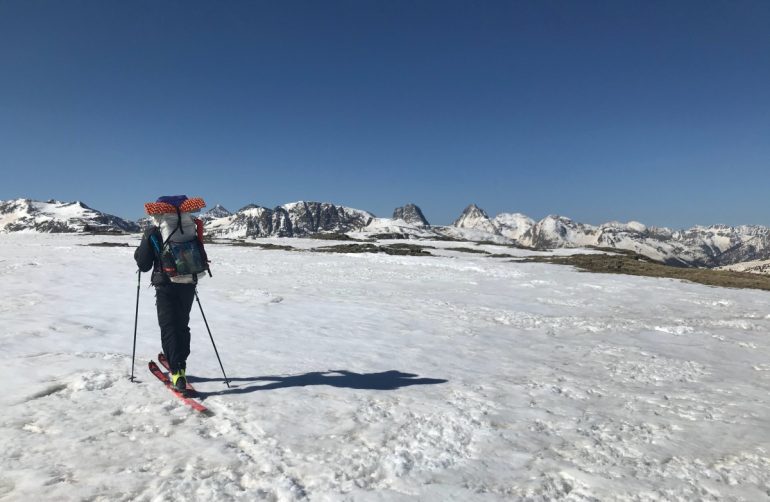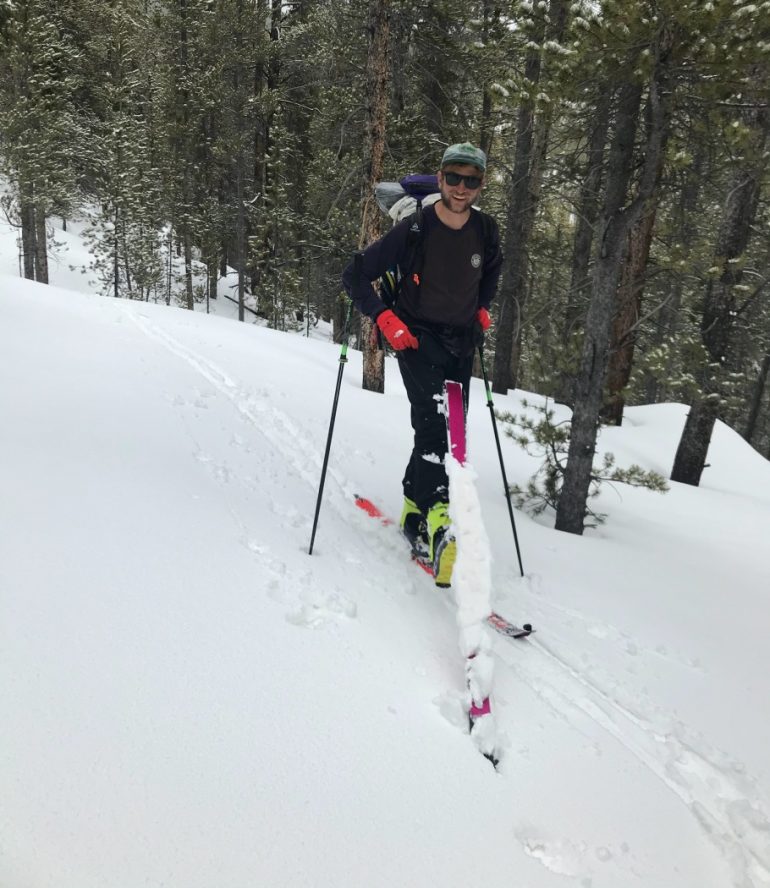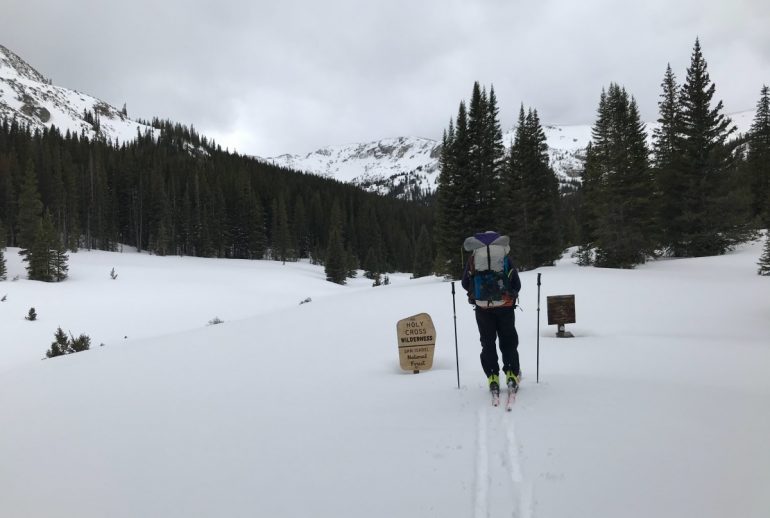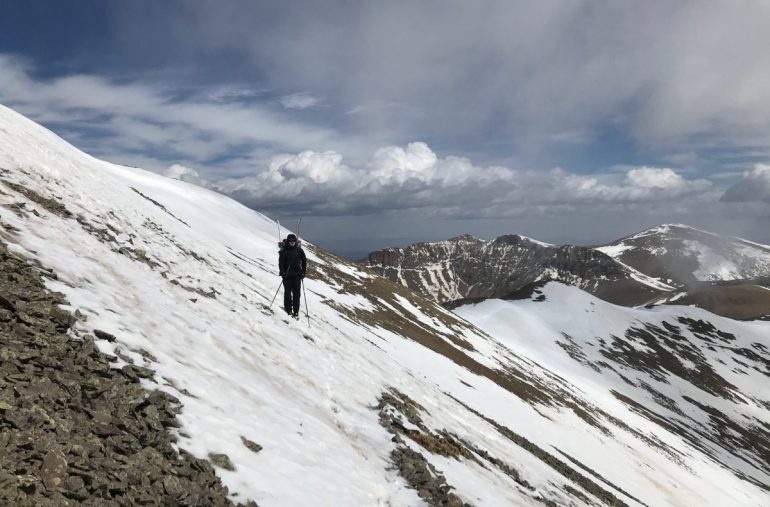
Mark skinning up high in the San Juans. Besides a spattering of old snowmobile tracks, we saw hardly any signs of human activity on the back half of our trip.
On May 6, 2022, my partner and I completed a spring ski traverse of the Colorado Trail. Our route closely followed the official trail corridor, with a few minor reroutes to navigate avalanche hazards and to follow more skiable terrain. You can read a full trip report on my blog: walkskicyle.com. We spent 27 days on trail, where we hardly saw any other travelers. We hiked through a couple of busy civilized locations, but besides the 30 miles of trail closest to Denver and the 10 miles of trail closest to Durango, we only saw two other groups, both out for day hikes. While we were one another’s sole company for much of this trip, we hardly did it alone. We relied heavily on our community to make this trip happen, and we are grateful for their positivity and willingness to facilitate this journey.
Setting out on The Colorado Trail
The alarm buzzed us awake at 4 am to fresh snow falling atop our tent. Mark and I were about 150 miles into our ski traverse of the Colorado trail, camped out near Leadville in the Holy Cross Wilderness area. We awoke groggy, wanting more sleep, but stirred at the thought of the long day ahead of us to our resupply in Twin Lakes. The friendly faces and pizza waiting there were motivating even as we hurried through our morning at camp: checking maps, sipping hot drinks, spooning oatmeal, and rushing out of our sleeping bags to accommodate an inevitably urgent poop.
We packed up our tent amidst the snowfall and began navigating the rolling terrain through the foothills of the Sawatch range. We would spend the rest of our day picking our way through the trees in this surprisingly taxing terrain.
And after a few more hours of light snowfall, the sun began poking out through the now intermittent cloud cover, presenting us with another set of challenges. The warming sun: jacket off, a burst of snow as clouds rolled through: jacket on, a steep climb: jacket off, a few hundred yards of downhill skiing: jacket on; we stopped and started, stopped and started.
As the day warmed, the fresh snow began to stick and clump to our ski bases and skins. Stride, glop; stride, glop. These conditions combined with the reality of traveling a sparsely marked trail corridor, meant that no amount of motivation would propel us forward at our desired pace. In this dense forest it was beneficial to be traveling on the official trail corridor, but without a packed in tread, we scanned for cut logs, branches, or blazes that marked the trail, else we stop to check and recheck our location on CalTopo almost any time the trail crossed a meadow or break in the trees.

Atop a high ridge, the author rips skins during a ski traverse of The Colorado Trail.

The dreaded clump! Sticky snow adhering to our skins slows our pace to a crawl.
As we slugged on through the clumpy snow we had to time and time again reach out to our friends with our resupply to let them know that we would be just that much later than we had originally expected. We inched onward. The calculus of skin management in the sticky snow was obsessive; there were points when striding uphill with no skins was most efficient. But that strategy could change in an instant. Less than six miles from our resupply point we were finally free of clumping snow, but instead found collapsing slush at that lower elevation. We relayed a text on the InReach, amending our arrival time once again, as we postholed sometimes waist deep with our skis on our feet. At 8 pm we were finally packing our skis for the final mile push through mud to make it to the South Mt Elbert trailhead.
Our friends pulled up just as we reached the parking lot. Alex and Jordan jumped out of the truck with big smiles, greeting us with hugs and lots of excitement– “You made it! To here!”
We were still quite a ways off from our final terminus, but it did feel like we had made it somewhere important. I had dropped off our resupplies just over a week before, but Mark and I were already so fully engrossed in our trail routine that that felt like months ago.
By the time we had repacked our resupply and swallowed our dinner, it was already time for Alex and Jordan to head out. They had to return to Salida forwork and Mark and I were exhausted from our longest day up to that point, so we didn’t get to spend more than 30 minutes chatting before we parted ways. Still, Mark and I agreed we were thankful to have had that time with our friends. We felt rejuvenated even after a short visit. The positivity and perspective from someone other than one another boosted our confidence and fueled our excitement for the next stretch of trail.

Mark treads through a few inches of fresh as we enter the Holy Cross wilderness area on our way to our resupply near Twin Lakes.

The official trail corridor of the Colorado Trail. The trail runs roughly 485 miles from outside Denver to Durango. Map: The Colorado Trail Foundation.
Months prior, when planning our resupplies, we decided to take advantage of the many road crossings to keep our packs light. We were also packing our food in advance, eliminating the need to spend any trail time at the grocery store deciding what we would be eating for dinner for the next week. Initially, we thought we would follow the traditional thru-hiker method of resupplying; mailing packages general delivery to post offices along the route then hitching into town where the trail crossed a highway. As our planning progressed, we realized we had friends in almost every trail town, and by relying on that resource would further cut down on our time off-trail.
We contacted some of our closest friends and asked for their help. We had friends hold or deliver all but three of our eight resupplies. While we had only considered the logistical advantages of this strategy when planning the trip, we quickly found that the mental boost of seeing our friends along the way was integral to maintaining a positive attitude.
On trail, Mark and I hardly saw any other travelers. While the challenges of navigating and maintaining a basic level of self-care kept us occupied all day, we found ourselves missing the company of other people. We weren’t tired of one another, but we were starved for conversation topics. At camp, we often read aloud our food packaging to one another then discussed the merits of that label compared to another. Never mind we had read the same food labels thrice over the day before. Arriving to a resupply with friends was then a welcome opportunity to socialize during this often quiet experience.

Hiking ove the ten-mile range after leaving our friend’s house in Breckenridge.
Beyond the excitement of sharing stories with and hearing from other people, our friends provided practical encouragement. When Mark and I set out, we knew that many unforeseen variables meant a real possibility of not finishing. Arriving at our friend Bart’s house, just five days into the hike, however, we were greeted with none of that angst or uncertainty. Instead, we were given hot showers and reassured that if we had made it this far we would have to make it the rest of the way. While we had tentatively talked amongst one another about the reality of finishing, it was the first time we had heard someone declare it so confidently. It was true that there were many unplanned obstacles, but it was also true that we would see this attempt through to the end.
These obstacles came in many different shapes and sizes, but we were able to manage all of them with the help of our friends. From the onset, we had to ask our friend Brian for a last minute ride to the trailhead when our original plan fell through. At various points on the trail Mark borrowed pants, a spoon, and an avalanche probe. I borrowed sunglasses, a Nalgene, and we used a friend’s sewing machine to make repairs after our stove malfunctioned and melted out a foot wide hole in our tent.
While Mark and I are adept at encouraging one another up a steep slope, or through a difficult day, seeing our friends kept the experience in perspective; and a positive one at that. Packing up camp with icy fingers and toes, spending hours above treeline in the wind, or dealing with sopping boots at the end of a long day made it easy to get caught up in daily challenges. Interacting with folks who knew, and were excited about what we were doing, made it easier to feel the same excitement even when facing the less glamorous aspects of this trip.

At the terminus is Durango.
After spending almost every free day of our winter season planning and preparing, having visits with friends built into our trail experience was a five star luxury. It became quickly obvious how integral their help was to our completion of the trail. This trip was hard on gear, and it was hard on us, physically and mentally. Months of research and training brought us a long way to meeting our needs on trail. But there was plenty of space for failure that might have left us a ways off from finishing had it not been for the support of our community.
